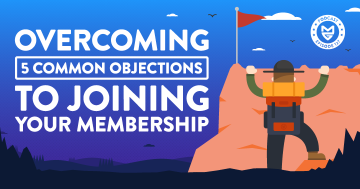You're excited to launch your membership and are working through the planning process – validating your idea, researching your audience and the market place…
And then you see it.
A huge well-known brand already has a membership – just like yours – and is operating in your target market.
Or maybe you've already launched your membership, but are quickly running out of ideas on how to standout from the big names in your space.
Either scenario is a difficult one to manage.
The thought of competing against a major player can be daunting to say the least…
However, it can be done.
Whatever stage you’re at, you can compete by employing some simple tactics that not only ensure your membership survives, but thrives in a competitive market.
Read on to find out what they are…
1. Find your ‘why’ and your unique place in the market
The first thing you need to do is zero in on what makes you different.
In other words, you need to define your ‘why.’
Begin by asking yourself, ‘Why do I exist’?
This blog was actually inspired by a post inside Membership Academy that sparked an interesting conversation.
The member, who has a photography membership, found that there are some very big players in his market with years of experience…
And as a newcomer, he was struggling to work out how he could set himself apart from the other juggernauts, especially when one competitor in particular, had hundreds of courses and material spanning back years.
I understood his concerns… I'm sure we all do – right?
But what if this situation presents an opportunity for his membership?
Think about it like this…
Some of his potential members – budding photographers – might have read lots of books, joined memberships and taken numerous courses, but somehow they've still not found what they're looking for.

This guy knows…
Why is that?
Because no one has given them what they really need.
That means the market still needs someone…
And our member could be it!
He simply needs to plug that gap with his membership.
That's his ‘why'…
Why he exists and what makes him different to his competition.
To do the same for your membership, ask yourself these questions:
- Why does this saturated market still need me?
- What is my purpose for entering this space?
- What is it that my competitor is doing that I stand against?
- What needs are not being met?
- What isn’t being said?
- What isn’t being taught?
- What is my audience sick of?
- What do I bring the to table that's new?
Answering these questions will help you determine the main problem that your membership solves.
Also, focusing on what your competitors aren’t doing while emphasizing your point of difference gives you an edge.
The ‘why' of what you do can be a hugely compelling part of why people choose you over your competitors, so make sure you use it in your marketing.
2. Specialize in ‘what’ you do and ‘who’ you target
Consider specializing your membership and niching down to become more focused.
Your audience will naturally be drawn to the membership they feel best solves their specific problems and matches their situation.
Try niching down based on what you offer.
Let’s go back to a photography example…
A wedding photographer might be drawn to a smaller membership specific to their particular segment of the industry – wedding photography – rather than a larger, generic photography membership because it's more specific to their needs.
But, specialization is not just about niching down the topic.
As well as specializing in what you do and the subject you teach, you can also specialize in who you do it for and how you do it.
A membership that specializes on the ‘what’ and the ‘who’ might look like this…
- Yoga for middle-aged men
- Personalized development for women in executive positions
- Parenting skills for low-income families
The ‘who’ can make a massive difference in terms of how appealing your membership is against that of your competitors.
If you're a middle-aged man who wants to learn yoga, you're going to be drawn to a membership that is targeting middle-aged men, as opposed to a generalized introduction to yoga.
The courses offered and the community discussions will be a better fit for that customer and put that yoga membership way ahead of the competition.
If you can offer something that specializes and caters to a specific segment, then you're going to stand out and beat your competition every single time.
3. Don’t focus on the ‘how’
The ‘how’ can also be a big differentiator, but it’s the thing people care the least about.
The ‘how' for us as membership site owners is that we're using the membership model.
That's a differentiator in itself…
The specific details of what your membership does and how you do it aren’t going to make you stand out from the competition…
After all, most memberships will have courses, Facebook groups, communities and Q&As.
The ‘what’ and the ‘who’ are where you can hone your targeting and focus your membership.
So, when someone is choosing between you and your competitor, they will find it a no-brainer to go with you.
4. Share your story
People do business with people.
This is why you need to showcase your personality, your brand, and be accessible to your members.
Bob Burg, the author of “The Go-Giver”, famously coined the term “Know, Like, Trust”.
This means that people will do business with people they know, people they like, and people they trust.
You can build that trust by focusing on your personal brand.
This is where content marketing comes in…
Many people have joined our membership because they've listened to my podcast and got to know me.
This is the platform we use to demonstrate our credibility and expertise…
It's also the place where our audience gets a sense of who I am…
My key drivers, experiences, passion for memberships and my personality.
If a person feels like you understand them, know what they’re going through, or have encountered the same obstacles, then that level of relatability can make your membership far more compelling.

When your audience connects with your story and can't get enough of your content…
Maybe your competitors are faceless corporate entities…
But, you have the opportunity to show your face.
If you do that, you'll not only build direct connections and trust, but you'll also standout in your market.
So how can you convey your personal brand?
Simple: Share your story.
To do this you should…
- Embrace the personal side of your membership
- Tell your origin story about how you got started
- Share the behind the scenes of your membership
- Share insights from your life and let people know who you are
- Share your successes from your memberships
- Share your member stories
All of this will build closer connections that will put your membership head and shoulders above the competition.
Not only that, it will make you seem more accessible to the outside world…
Something your members will experience as part of your community.
Bigger memberships often can’t compete with that personal, visible, and accessible nature of smaller memberships.
With established memberships that have thousands of members, you’ll often find that the founder is simply not accessible.
Due to the sheer size of the membership, they probably don't often show up to Q&As and aren’t personally involved with their members.
If you make yourself fully accessible to your members, that’s a big string to your bow that your competitors can’t logistically compete with.
Your members should see you as a credible, reliable resource, an expert in your field, and have the belief that they can get access to you.
This is a really compelling benefit of your membership over that of your competitors.
5. Avoid cheap differentiators and pointless gimmicks
What do we mean by this?
“Hey! We offer the same as the big guys, but we’re cheaper!”
“We're the only membership in our industry who send all new students a free keyring!”
It’s a point of difference, but it’s definitely not a compelling point.
Even if you find yourself scrambling around for ideas to try and compete, don’t go for the gimmicks.
They are easy to replicate and don’t offer any value that will help you stand out.
6. Embrace being the underdog
If you’re an underdog, then embrace that.
People invariably root for the underdog in most situations.
If your competitor is the establishment, then you’re what’s fresh, new, and exciting.
You can then position yourself as the one that is edgier, more targeted, or adaptable compared to those older juggernauts.
Underdogs are also relatable and inspirational.
They are often down to earth and seen as more in tune with what the people want because they're just like them.
So don’t shy away from it…
Instead, embrace that positioning in your marketing and use it in your favor.
Don’t disguise that you are new and young, as what you might be concerned is a weakness, is actually a benefit.
Being the underdog is a great way to compete with the big players and draw members to you.
7. Turn being small into a big benefit for members
If you have a just a few members – refer to it as an intimate community.
With that change in terminology, you’ve created a feature that’s very appealing.
A small community means that you pay more attention to your members.
Another benefit of your size is that you can adapt to member feedback, correct things that don’t work, and incorporate new ideas quicker.
As well as being more reactive, being part of a smaller community means that members get to influence the your membership’s direction.
Memberships are always evolving…
A lot of that stems from observing what members are doing and optimizing your structure to enhance that.
The people who get in on the ground floor become a big part of what your membership will go on to be.
With a small membership, your members will have more of a voice than if they went to a membership with a quarter of a million people where they are just a number.
So, embrace your size and see it as a benefit rather than a weakness.
8. Switch your focus from quantity to quality content
Going back to the source of the inspiration for this post, what the photography membership owner zeroed in on was the fact that his biggest competitor had oceans of content.
He felt like he had an insurmountable mountain to climb and that he would not be able to make a case for his membership and never be able to compete.
What you need to remember, however, is that when people join your membership, they are not buying your content, they are buying what the content enables them to do.
Even if a membership has masses of content it doesn’t make it better.
Your content may help your members achieve their goals quicker, or be more relevant or more up to date than your competitors’.
Your 5-minute video tutorial may be so much more succinct and valuable than your competitor's 10-hour course.
That’s why it’s important to think about how your content adds value.
Value is all based on how well and how effectively you help people achieve results from your membership.
If you can get them the same or better results quicker, it doesn’t matter about that intimidating competitor.
9. Help people navigate your content
If you can provide members with a personalized, tailored, or even a guided experience on how to navigate your content, that can be worth its weight in gold.
Try giving new members guidance on where they should start or existing ones ideas about what they should do next.
You could offer…
- A step-by-step pathway to the outcome they seek, which will set you apart from the competitors who can often dump members into a bottomless pit of content.
- A personalized roadmap, perhaps with a recommendation engine that captures member's requirements and then creates personalized suggestions, or…
- Welcome calls to gather more information on member needs so you can then give them individual recommendations about where to start.
Implementing any of these approaches into your membership will definitely help you blow the competition out of the water.
Often with bigger and long-established memberships, when a member signs up, they are simply left to their own devices.
However, if you can provide a guided or personalized experience, your membership will be so much more compelling than your competitors’.
10. Look for opportunities that competing memberships aren’t exploiting
Are there services your competitors aren't prioritizing, a gap in content creation or social media channels where they little to no presence?
Do they have a podcast?
Do they have low follower numbers on Instagram?
There could be multiple opportunities that your competitor is not taking advantage of that you can…
That being said, you shouldn't avoid marketing in similar spaces or relinquish a channel to them if it's the right one to use for your membership.
For example, if they have a YouTube channel, you can still post videos that compete if you remember to differentiate on your ‘why’ and your ‘who’.
Older memberships can have a habit of becoming locked into an established pattern of doing things.
It means that they probably haven’t adapted to social media changes or tried new tactics or channels – like TikTok for example.
Look for those opportunities, exploit them, and challenge your competitors.
So what shouldn’t you do when competing with big players?
There are definitely some don'ts when it comes to competing with established brands in your space…
Some of them have been touched on in previous points, but it's worth highlighting them on their own.
Don’t trash your competitors
It’s one thing to use the failings of your competitors, but you don’t want to fill your channels every week moaning about how terrible they are.
If you start trashing the competition in your content, it will inevitably backfire.
You’ll attract some people who will find it funny, but it takes a lot of skill to be able to pull off that anti-industry angle.
People who try that rebellious voice end up being negative and putting people off, rather than attracting them.
Don’t try copying and mirroring what you competitors are doing
Don’t copy their logos.
Don’t go with a similar color scheme.
Don’t go with a similar name.
People don’t want cheap knock offs.
Be distinctive. Be your own brand. Be you.
Don’t mimic or copy competitors’ content
Don’t rip off the competitors' material either.
Unfortunately, some people steal content and change a few words.
Don’t do it.
It’s illegal and you will get caught out.
You should create and offer your members fresh original content.
Content that adds value and sets you apart from your competitors.
Don’t steal members
Don’t be underhand and try to steal their members.
Don’t go into their Facebook groups and start promoting your stuff.
Don’t reply to people who are tweeting your competitor and start plugging your product.
Even worse, don’t join their membership and start sending private messages to their members to get them to join your community.
Yes, that happens!
Don’t try competing on price
The problem with competing on price is that there is usually only one direction you can go – down.
That doesn’t mean you can’t charge lower if that works for your membership, however, you shouldn’t focus your entire marketing strategy and point of difference on price.
There will always be someone cheaper.
Focus on your value, your personal brand, and your ‘why’.
What you should remember when dealing with competing memberships…
The existence of these competitors is a good thing.
The more content circulating on your topic means that more people will become aware of your subject.
It allows you an opportunity to be found.
As the saying goes, ‘a rising tide raises all boats'.
A lot of competitors just raises interest and potential for your membership, so don’t resent the existence of competition in your market.
Instead, consider if it would be better to have a more collaborative mindset
There could be opportunities for you and certain competitors to team up and work together for mutual benefit.
The chances are your market is way bigger than you'll ever be able to serve yourself anyway…
You don’t need the whole pie, just a piece of it.
Have you heard of Kevin Kelly’s concept of 1,000 true fans?
This is the idea that any creator just needs 1,000 loyal fans who will love your content and pay for your products or services.
If you have 1,000 people paying you $50 a month, that’s $600,000 per year!
I think this figure would make most people happy, don't you?
Think about your 1,000 true fans and utilize the tips in this post to compete with those established memberships in your market.
Even if your competitor has more members, more content, or been around longer, you can still compete, and get your share of the pie.





